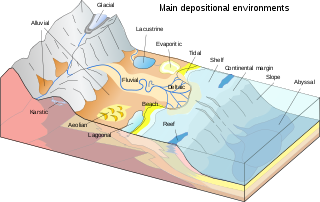Depositional environment

In geology, depositional environment or sedimentary environment describes the combination of physical, chemical and biological processes associated with the deposition of a particular type of sediment and, therefore, the rock types that will be formed after lithification, if the sediment is preserved in the rock record. In most cases the environments associated with particular rock types or associations of rock types can be matched to existing analogues. However, the further back in geological time sediments were deposited, the more likely that direct modern analogues are not available (e.g. banded iron formations).
Contents
1 Types of depositional environments
2 Recognition of depositional environments in ancient sediments
3 References
4 External links
Types of depositional environments

Diagram to show the different depositional environments in which tsunami deposits are formed - partly after Shanmugam 2006 [1]

Depositional environmental model of the Araripe Basin formations, NE Brazil
Continental
- Alluvial
Aeolian – Processes due to wind activity- Fluvial
- Lacustrine
Transitional
Deltaic – Silt deposition landform at the mouth of a river- Tidal
Lagoonal – A shallow body of water separated from a larger body of water by barrier islands or reefs
Beach – Area of loose particles at the edge of the sea or other body of water
Lake – A body of relatively still water, in a basin surrounded by land
Marine
Shallow water marine environment
Upper shoreface – The portion of the seafloor that is shallow enough to be agitated by everyday wave action
Lower shoreface – The portion of the seafloor, and the sedimentary depositional environment, that lies below the everyday wave base
Deep water marine environment – Flat area on the deep ocean floor
Reef – A bar of rock, sand, coral or similar material, lying beneath the surface of water
Others
Evaporite – A water-soluble mineral sediment formed by evaporation from an aqueous solution- Glacial
- Volcanic
Tsunami – Sedimentary unit deposited by a tsunami
Recognition of depositional environments in ancient sediments
Depositional environments in ancient sediments are recognised using a combination of sedimentary facies, facies associations, sedimentary structures and fossils, particularly trace fossil assemblages, as they indicate the environment in which they lived.
References
^ Shanmugam G. (2006). "The Tsunamite Problem" (PDF). Journal of Sedimentary Research. 6: 718–730. doi:10.2110/jsr.2006.073..mw-parser-output cite.citation{font-style:inherit}.mw-parser-output .citation q{quotes:"""""""'""'"}.mw-parser-output .citation .cs1-lock-free a{background:url("//upload.wikimedia.org/wikipedia/commons/thumb/6/65/Lock-green.svg/9px-Lock-green.svg.png")no-repeat;background-position:right .1em center}.mw-parser-output .citation .cs1-lock-limited a,.mw-parser-output .citation .cs1-lock-registration a{background:url("//upload.wikimedia.org/wikipedia/commons/thumb/d/d6/Lock-gray-alt-2.svg/9px-Lock-gray-alt-2.svg.png")no-repeat;background-position:right .1em center}.mw-parser-output .citation .cs1-lock-subscription a{background:url("//upload.wikimedia.org/wikipedia/commons/thumb/a/aa/Lock-red-alt-2.svg/9px-Lock-red-alt-2.svg.png")no-repeat;background-position:right .1em center}.mw-parser-output .cs1-subscription,.mw-parser-output .cs1-registration{color:#555}.mw-parser-output .cs1-subscription span,.mw-parser-output .cs1-registration span{border-bottom:1px dotted;cursor:help}.mw-parser-output .cs1-ws-icon a{background:url("//upload.wikimedia.org/wikipedia/commons/thumb/4/4c/Wikisource-logo.svg/12px-Wikisource-logo.svg.png")no-repeat;background-position:right .1em center}.mw-parser-output code.cs1-code{color:inherit;background:inherit;border:inherit;padding:inherit}.mw-parser-output .cs1-hidden-error{display:none;font-size:100%}.mw-parser-output .cs1-visible-error{font-size:100%}.mw-parser-output .cs1-maint{display:none;color:#33aa33;margin-left:0.3em}.mw-parser-output .cs1-subscription,.mw-parser-output .cs1-registration,.mw-parser-output .cs1-format{font-size:95%}.mw-parser-output .cs1-kern-left,.mw-parser-output .cs1-kern-wl-left{padding-left:0.2em}.mw-parser-output .cs1-kern-right,.mw-parser-output .cs1-kern-wl-right{padding-right:0.2em}
- Harold G. Reading. 1996. Sedimentary Environments: Processes, Facies and Stratigraphy. Blackwell Publishing Limited.
External links
- Sedimentary Environments Classification Charts
- Depositional environments on e-notes
This geology article is a stub. You can help Wikipedia by expanding it. |

Comments
Post a Comment